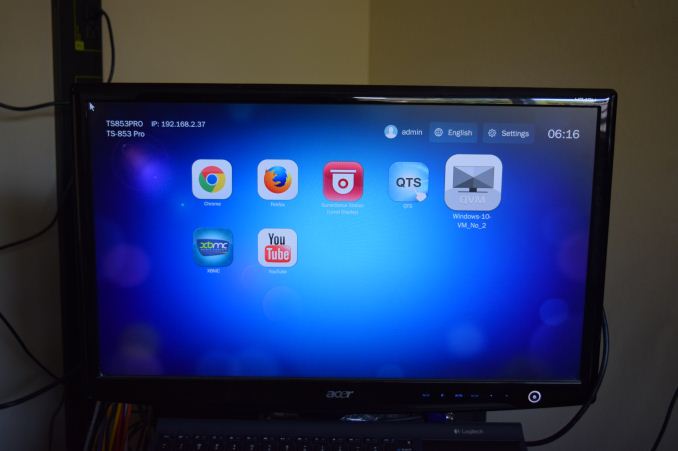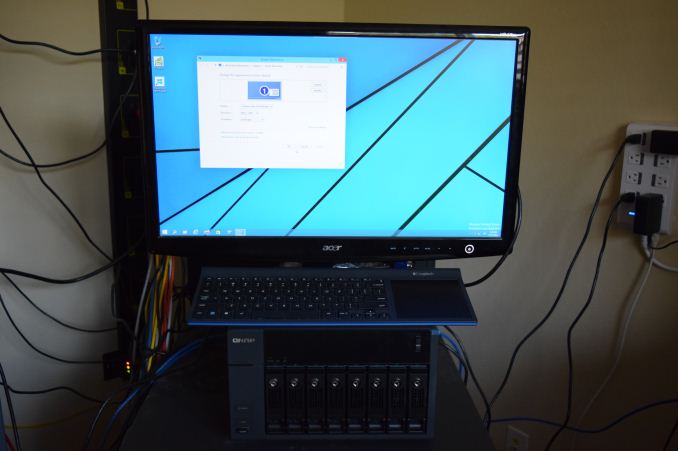QNAP TS-853 Pro 8-bay Intel Bay Trail SMB NAS Review
by Ganesh T S on December 29, 2014 7:30 AM ESTQNAP's HD Station - QvPC Explored
Over the last few years, QNAP has been introducing various interesting packages for their QTS operating system. XBMC was one of the first to take advantage of the HDMI display output on their NAS units. Slowly, a few other packages such as web browsers, NAS management interfaces and YouTube were introduced. Recently, QNAP decided to bundle all these packages under the Hybrid Desk Station (HD Station) moniker.
The ability to interact with the NAS using a keyboard and a mouse brought it closer to a traditional PC for the average consumer. Virtualization Station was the final piece in the puzzle. QNAP added an option to display the console of each VM on the display output desktop (a QVM option) in the Virtualization Station settings. This enables end users to interact not only with the QTS desktop, but also with a Windows or Ubuntu VM as if it was running on a physical machine.
QNAP's HD Station Interface with QVM Activated
Recognizing the big leap made in HD Station using QVMs, QNAP has opted to do a branding exercise - QvPC - for this feature set. In addition to QVMs, HD Station also includes a local output for the tracked surveillance cameras, XBMC with HD audio bitstreaming and other miscellaneous features. QNAP's product page for HD Station adds more marketing detail to what we have covered above.
Windows 10 on a QNAP TS-853 Pro-8G - QvPC
Our usual NAS evaluation routine doesn't load up the NAS with non-NAS aspects while processing benchmarks. For the TS-853 Pro-8G, we did one pass with all four network links bonded and no extra packages active. However, with running VMs being a very attractive feature of the TS-x53 Pro series, we added two sets of benchmarks for the multi-client scenarios after configuring two Windows 10 VMs (two cores, 2 GB RAM and one dedicated network link each). This configuration left the other two network ports free for bonding / external traffic. The CPU cores themselves had to be shared between the VMs and the main NAS tasks (as all four cores ended up getting allocated to the VMs).
- 1 QVM: A Windows 10 VM with QVM configured was activated. PC Mark 8's 'Work' workload was run in a loop with HDMI output enabled, while the rest of the NAS was subject to storage traffic over the bonded network links
- 2 VMs: QVM was de-activated. Two Windows 10 VMs were configured for access via Remote Desktop. PC Mark 8's 'Work' workload was run in a loop on both VMs, while the rest of the NAS was subject to storage traffice over the bonded network links.
In addition to the above Virtualization Station configuration, we also found an interesting caching aspect in QTS. Our benchmarks are processed after turning off the write cache (EXT4 delay allocation) for all NAS units. However, QTS, in addition to the EXT4 delay allocation, has an additional system cache setting at the volume level. The large amount of RAM in the system (8 GB) also skewed the results quite a bit with the system cache settings enabled. QNAP is also one of the first COTS NAS vendors to support SMB 3.0. Obviously, this is available only for Windows 8 and Windows Server 2012 R2 and later operating systems. We tested out SMB 3.0 with a Windows 8 VM in our NAS testbed. In the rest of the review, we try to address as many different combinations as possible in the benchmarks.












58 Comments
View All Comments
ap90033 - Wednesday, December 31, 2014 - link
RAID is not a REPLACEMENT for BACKUP and BACKUP is not a REPLACEMENT for RAID.... RAID 5 can be perfectly fine... Especially if you have it backed up. ;)shodanshok - Wednesday, December 31, 2014 - link
I think you should consider raid10: recovery is much faster (the system "only" need to copy the content of a disk to another) and URE-imposed threat is way lower.Moreover, remember that large RAIDZ arrays have the IOPS of a single disk. While you can use a large ZIL device to transform random writes into sequential ones, the moment you hit the platters the low IOPS performance can bite you.
For reference: https://blogs.oracle.com/roch/entry/when_to_and_no...
shodanshok - Wednesday, December 31, 2014 - link
I agree.The only thing to remember when using large RAIDZ system is that, by design, RAIDZ arrays have the IOPS of a single disk, no matter how much disks you throw at it (throughput will linearly increase, though). For increased IOPS capability, you should construct your ZPOOL from multiple, striped RAIDZ arrays (similar to how RAID50/RAID60 work).
For more information: https://blogs.oracle.com/roch/entry/when_to_and_no...
ap90033 - Friday, January 2, 2015 - link
That is why RAID is not Backup and Backup is not RAID. ;)cjs150 - Wednesday, January 7, 2015 - link
Totally agree. As a home user, Raid 5 on a 4 bay NAS unit is fine, but I have had it fall over twice in 4 yrs, once when a disk failed and a second time when a disk worked loose (probably my fault). Failure was picked up, disk replaced and riad rebuilt. Once you have 5+ discs, Raid 5 is too risky for me.jwcalla - Monday, December 29, 2014 - link
Just doing some research and it's impossible to find out if this has ECC RAM or not, which is usually a good indication that it doesn't. (Which is kind of surprising for the price.)I don't know why they even bother making storage systems w/o ECC RAM. It's like saying, "Hey, let's set up this empty fire extinguisher here in the kitchen... you know... just in case."
Brett Howse - Monday, December 29, 2014 - link
The J1900 doesn't support ECC:http://ark.intel.com/products/78867/Intel-Celeron-...
icrf - Monday, December 29, 2014 - link
I thought the whole "ECC required for a reliable file system" was really only a thing for ZFS, and even then, only barely, with dangers generally over-stated.shodanshok - Wednesday, December 31, 2014 - link
It's not over-stated: any filesystem that proactively scrubs the disk/array (BTRFS and ZFS, at the moment) subsystem _need_ ECC memory.While you can ignore this fact on a client system (where the value of the corrupted data is probably low), on NAS or multi-user storage system ECC is almost mandatory.
This is the very same reason why hardware RAID cards have ECC memory: when they scrubs the disks, any memory-related corruption can wreak havoc on array (and data) integrity.
Regards.
creed3020 - Monday, December 29, 2014 - link
I hope that Synology is working on something similar to the QvM solution here. The day I started my Synology NAS was the day I shutdown my Windows Server. I would, however, still love to have an always on Windows machine for the use cases that my NAS cannot perform or would be onerous to set up and get running.